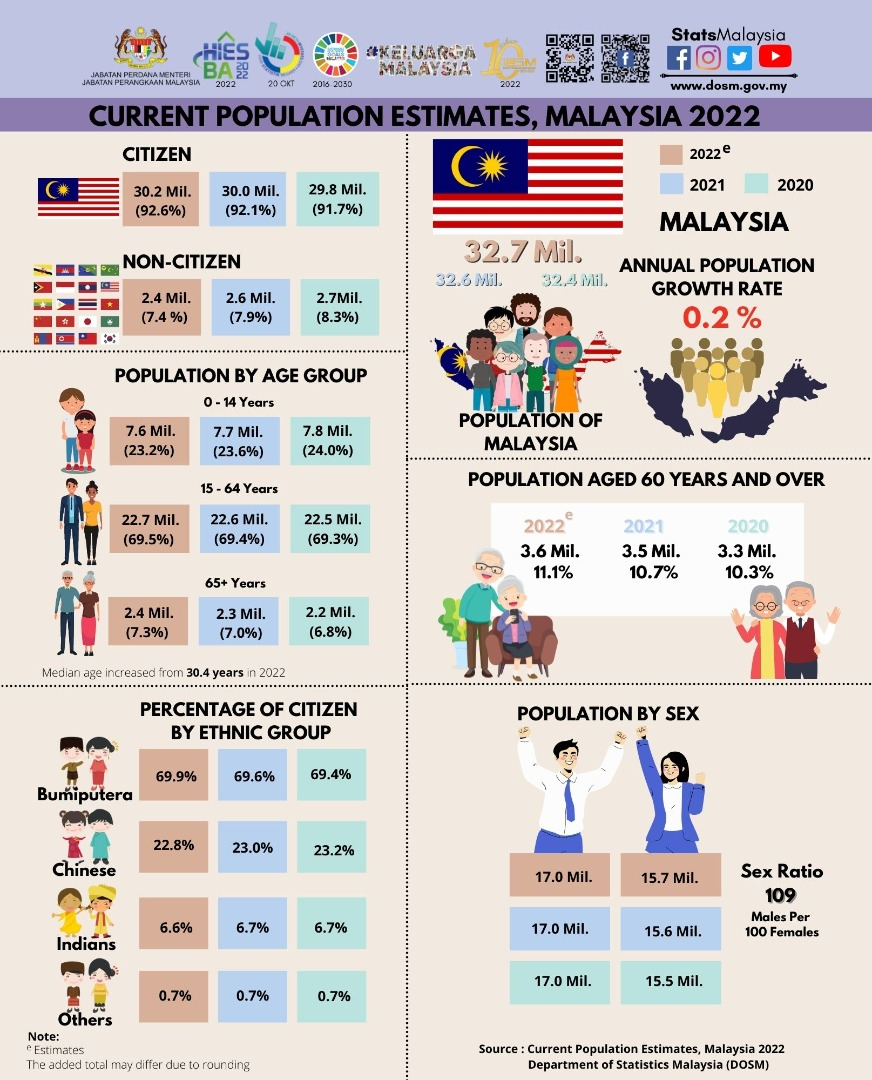KUALA LUMPUR, July 29 — The total population of Malaysia this year is estimated at 32.7 million, with a 100,000 increase from 32.6 million in 2021 with an annual population growth rate of 0.2 per cent.
The country is also facing a declining population growth rate due to the lower number of non-citizens from 2.6 million (2021) to 2.4 million (2022), Department of Statistics Malaysia (DOSM) chief statistician Datuk Seri Mohd Uzir Mahidin said in a statement today.
"This is in line with the restriction on international travel by countries during the spread of the Covid-19 pandemic worldwide in 2020 and 2021.
"The citizens' population increased from 30 million in 2021 to 30.2 million in 2022 with the growth rate decreasing from 0.8 per cent to 0.7 per cent over the same period,” he said with the release of the Current Population Estimates 2022 report.
He added that the slower population growth trend also occurred in other countries such as Singapore (-0.3 per cent), Australia (1.3 per cent), the United Kingdom (0.4 per cent), Japan (-0.3%), New Zealand (1.3%) due to the decrease in total fertility rate and international net migration as well as increase in the number of deaths due to ageing.
The composition of the citizen population in 2022 is 92.6 per cent, an increase of 0.5 percentage points as compared to 2021 (92.1 per cent) while the composition of the non-citizen population continued to decline from 7.9 per cent to 7.4 per cent during the same period.

As for population by sex, DOSM found that males outnumbered females this year.
"In 2022, the male population exceeds the female population at 17 million and 15.7 million respectively. The gender ratio for overall population is 109 males for every 100 females.
"For the period 2021-2022, the gender ratio for citizens remains at 103 and non-citizens 227 males for every 100 females respectively. The higher ratio of males is attributed to the higher number of males for non-citizens,” he said.
Under the age structure, Uzir said the elder population in Malaysia is increasing every year whereby the composition of the population aged zero to 14 years (young age) in 2022 decreased to 23.2 per cent as compared to 23.6 per cent in 2021.
"Meanwhile, the composition of the population aged 15 to 64 years (working age) increased from 69.4 per cent in 2021 to 69.5 per cent in 2022,” he said.
According to the findings, Uzir said the decline in this working age group is due to the composition of male foreign workers for non-citizens.
"The percentage of the population aged 65 and over (old age) increased from 7.0 per cent to 7.3 per cent for the same period.
"Based on the United Nations definition, Malaysia has become an ageing society. In addition, the median age also increased from 30.1 years in 2021 to 30.4 years in 2022,” he said.
He added that of the 30.2 million citizens, the composition of Bumiputera increased by 0.3 percentage points to 69.9 per cent in 2022 as compared to 69.6 per cent in 2021.
However, the composition of the ethnic Chinese and Indian populations decreased to 22.8 per cent (2021: 23.0 per cent) and 6.6 per cent (2021: 6.7 per cent) respectively. Others remained at 0.7 per cent, said Uzir.
For population by state, the three states with the highest population composition in 2022 are Selangor (21.6 per cent), followed by Johor (12.3 per cent) and Sabah (10.4 per cent).
"Federal Territories of Labuan and Putrajaya recorded the lowest population composition at 0.3 per cent and 0.4 per cent respectively. However, Putrajaya recorded the highest annual population growth rate for the period 2021 to 2022 which is 4.3 per cent.
"For the first time, the population of Melaka surpassed one million mark in 2021,” he said.
Uzir also noted on average, Malaysia has a population density of 99 people per square kilometre, Kuala Lumpur has the highest population density with 8,045 people per square kilometre, followed by Putrajaya (2,418) and Penang (1,656).
Meanwhile, Sarawak has the lowest population density with 20 people per square kilometre, followed by Pahang (45) and Sabah (46).



















